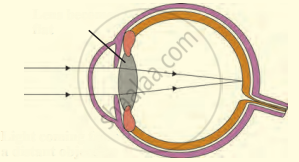Advertisements
Advertisements
प्रश्न
Mention if the following statement is true (T) or false (F) Give reason.
Short-sightedness and hyperopia are one and the same thing
विकल्प
True
False
उत्तर
False
short-sightedness is myopia and hyperopia is long-sightedness.
APPEARS IN
संबंधित प्रश्न
Write the function of the following part of the human eye: Cornea
The human eye can focus objects at different distances by adjusting the focal length of the eye lens. This is due to ______.
Compare the following: Choroid and retina
Write short notes on the following: Retina
Where is the image formed in a human eye?
What job does the pupil of the eye do?
Fill in the following blank with suitable word:
The part of eye which alters the size of the pupil is............
Explain why, we cannot see our seats first when we enter a darkened cinema hall from bright light but gradually they become visible.
Why does the eye-lens not have to do all the work of converging incoming light rays?
State whether the following statement is true or false:
Rabbit has eyes which look sideways.
Five persons A, B, C, D and E have diabetes, leukaemia, asthma, meningitis and hepatitis, respectively.
Which of these persons cannot donate eyes?
Name the following:
Short sightedness.
Name the respective organs in which the following are located and mention the main function of each:
(i) Iris
(ii) Semicircular canals
Differentiate between:
Yellow spot and Blind spot.
Complete the following sentence with appropriate Word
The aperture in the eye through which light enters is the:
Write the name.
The part of human eye that transmits electrical signals to the brain.
Write scientific reason.
The movie cannot be enjoyed if seat of a viewer is too close to the screen in the cinema.
The following figure show the change in the shape of the lens while seeing distant and nearby objects. Complete the figures by correctly labelling the diagram.

Match the following
| 1. | Conjunctiva | a. | Coloured part of eye |
| 2. | Cornea | b. | Photosensitive layer |
| 3. | Iris | c. | Refraction |
| 4. | Retina | d. | Protection |
Which of the following is responsible for the adjustment of the size of pupil?
